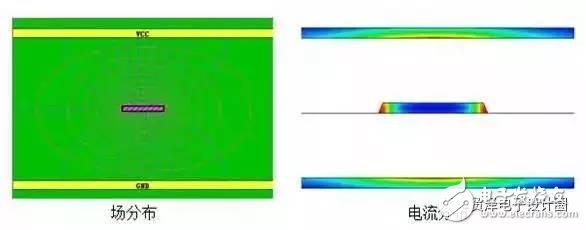Many people are confused about the reference plane of a PCB trace. A common question is: For an inner layer trace, if one side is connected to VCC and the other to GND, which one serves as the reference plane?

To understand this, it's essential to grasp the concept of a transmission line. In high-speed circuit design, transmission lines are used to analyze how signals propagate on a PCB. The basic structure of a transmission line consists of two key components: the signal path and the reference path (also known as the return path).
Signals travel through the PCB in the form of electromagnetic waves, and the signal path and reference path together create the physical medium for this wave propagation. From an electromagnetic perspective, these two elements form a unique structure that allows the wave to move. From a current loop standpoint, the signal path carries the forward current, while the reference path carries the return current. Hence, the reference path is also referred to as the return path.
For surface traces on a PCB, the trace and the underlying plane form the environment for electromagnetic wave transmission. It doesn’t matter whether the plane below is VCC, GND, or even isolated copper with no network connection — what matters is that it’s a conductor. As long as it’s a conductive plane, it can serve as a reference path.
The signal path is the surface trace, so the lower plane acts as the reference path. This configuration on the PCB makes the lower plane the reference plane. From the current loop perspective, it carries the return current of the signal, so it's also called the return plane. The figure below shows the field and current distribution for surface traces. At this point, the role of the reference plane should be clear: it forms part of the electromagnetic wave transmission environment and acts as the return path for the current.

Understanding the logic above makes the reference plane for inner layer traces more straightforward. The trace, along with the upper and lower planes, forms the environment for electromagnetic wave transmission. Thus, both the upper and lower planes act as reference paths, or reference planes. The field map below clearly illustrates the relationship between the physical structure and the field distribution.
From the current loop perspective, the current distribution diagram in the figure below also shows where the return current flows. If the spacing between the trace and both planes is similar, the return currents on both planes will be roughly equal. In such cases, both planes are equally important. That’s why we say both are reference planes. If you still don’t see why both are considered reference planes, take a closer look at the diagram. In every respect, the two planes are symmetrical. Why would you focus on just one? If one is a reference, why not the other?

The simplest way to think about the reference plane is to ask: “Does this structure support the transmission of electromagnetic waves?â€
Is this structure meeting the condition?
Can a wide area of isolated copper be used?
Of course. The conductor must be in a flat form to be called a reference plane. Otherwise, it's just a conductor, not a plane.
The previous article mentioned that when the distance between the trace and both planes is similar (which is common in multi-layer boards), the influence of both planes on the signal is comparable. However, in real engineering scenarios, sometimes one plane is much closer to the trace than the other. For example, in a 6-layer board, the core thickness is typically over 1 mm. The following figure shows a typical 6-layer stack-up. Both inner signal layers, InnerSignal1 and InnerSignal2, are surrounded by two planes. In such cases, the two planes may have different effects on the trace. So, which one is the reference plane now?

Let’s first look at the return current on the plane. For InnerSignal2, the VCC plane is far away. The figure below shows that the signal current is 10 mA (in red), and the return current on the VCC plane is only about 1.2 mA (in blue). The return current on the VCC plane is very small. Meanwhile, nearly 90% of the return current comes from the GND plane directly adjacent to InnerSignal2. Clearly, the GND plane has a much greater impact on the signal than the VCC plane.
Now let’s consider the effect of the VCC plane on the inductance of the InnerSignal2 trace. The next figure compares the trace impedance with and without the VCC plane. Even when the VCC plane is removed, there is little change in the trace impedance — less than 1 ohm, or about a 2% change. From an engineering perspective, we can approximate that the closest GND plane is the primary reference plane for InnerSignal2.
Although this is an approximation, the key takeaway is that the VCC plane far from InnerSignal2 isn’t completely ineffective, but its impact is minimal. Don’t overcomplicate things — it’s easy to get stuck if you always look for absolute answers. Instead, focus on the relative importance of each plane.
In high-speed signal integrity design, many issues are similar. What you should focus on isn’t whether something exists or not, but how much influence it has. By understanding this, you’ll have more confidence when working with complex PCBs and can better control signal behavior.
Electric Test Pen ,Battery Detector,Circuit Tester,Voltage Test Pen
YINTE TOOLS (NINGBO) CO., LTD , https://www.yinte-tools.com